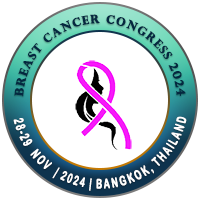
Zehra Pinar Koc
Mersin University, TurkeyTitle: The significance of the intramammary sentinel lymph nodes in the lymphatic mapping
Abstract
Aim: The limited numbers of series in the literature about the intramammary sentinel lymph nodes (IMSL) point out clinical significance of this entity. The aim of this study was to evaluate the pathologic status of the IMSLN’s as well as compare these results with sentinel node imaging and 18F- (Fluorodeoxyglucose) FDG Positron Emission Tomography/Computed Tomography (PET/CT) findings.
Materials and Methods: Thirty women (36-72; 52, mean: 73±11.19 years old) with the diagnosis of breast cancer who underwent SLN evaluation were the subject of this study. The all patients’ pathology results pointed out the IMSLN’s. There were 15 patients with 99mTc-nanocolloid sentinel lymph node scintigraphy and 23 patients with 18F- FDG PET/CT results. The detection rates of the imaging studies were analyzed and compared with pathology results.
Results: Four of the patients included in the study were operated previously (mastectomy) and the others primary tumor was 20,94±11,19 mm mean in size and the mean uptake value was 11,08±6,88 (SUVmax). The axillary lymph nodes that were observed in the 18F- FDG PET/CT were mean 13±8,66 mm in diameter and the mean SUVmax value of these lymph nodes was 5,3±5,4. The detection rate of the IMSLN’s in the 18F- FDG PET/CT was 7/23 (30,43%) and 5/15 (33,3%) in the sentinel lymph node imaging. Among the 29 IMSLN’s 16 were positive and IMSL’s were only metastatic lymph node in 7 patients. Additionally, in 5 of the patients with sentinel lymph node scintigraphy the sentinel node was not detected.
Conclusion: The IMSLN changed patients’ management in 7/30 patients in this study. The detection rates of neither the 99mTc-nanocolloid sentinel lymph node scintigraphy nor the 18F- FDG PET/CT was sufficient.
Biography
To be updated soon.

